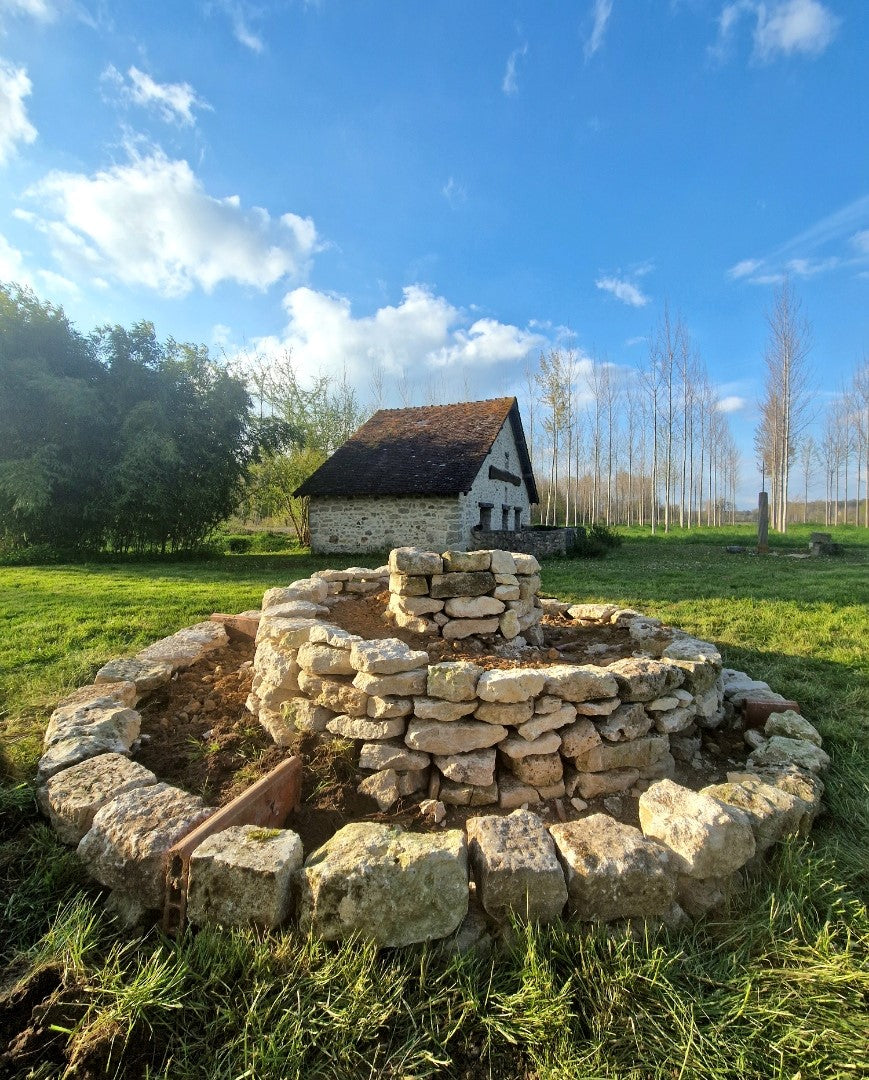
Creating an aromatic spiral
valérie demarsOn this International Mother Earth Day, we pay tribute to its beauty by creating an aromatic spiral at Jardin d'Aimée , the association created by Valérie Demars, perfumer of Aimée de Mars natural fragrances. The spiral is a sacred symbol of nature that manifests itself through the flow of runoff water, pine cones, snail shells, and even our fingerprints. In permaculture, it is a source of inspiration.
What are the advantages of an aromatic spiral?
The spiral layout in an organic garden is an innovative method for optimizing garden orientation and drainage. This shape allows for varying areas of light and shade throughout the day, creating dry and sunny habitats in the upper part and humid habitats in the lower part.
This method is based on dividing the spiral into zones with different climates, thus providing shaded or sunny conditions adapted to the needs of the plants. From the beginning to the end of the spiral, there are different types of biotopes, thanks to the transition between dry and humid habitats. This spiral arrangement also offers the possibility of planting a wide variety of herbs in a small space.
By cultivating an aromatic spiral, we create an ecosystem conducive to supporting biodiversity and pollinators. Indeed, the spiral creates ecological niches for insects and birds, which can find refuge and food there.
By growing a wide variety of herbs in this spiral, we also provide a food source for pollinators, such as bees and butterflies. These help pollinate plants, which is essential for the reproduction of plant species.
In short, growing an aromatic spiral is a simple but effective way to contribute to the preservation of the wonders of nature by creating a balanced environment that promotes biodiversity.
The steps in building an aromatic spiral
1. Choice of location and delimitation
Choosing the right location is crucial to ensuring the success of your project. We oriented the aromatic spiral toward the south, placing the lower end of the spiral there. We chose a clear spot with optimal sunlight throughout the day to encourage the growth of our aromatic plants.
To guide us later in the arrangement of each variety of plants, we positioned the bricks vertically according to the cardinal points: North, South, West and East.

2. Construction of the borders
Building the borders is a very important and time-consuming step in creating a sustainable aromatic spiral. We chose stone borders to allow for better plant establishment and create a habitat favorable to biodiversity. Stones also have the ability to retain heat absorbed during the day, reducing temperature fluctuations that could damage fragile plants. We use the dry stone method to assemble the stones, creating small gaps for wildlife to shelter in.
As we carefully built the wall, we came up with the idea of incorporating a small refuge for our four-legged friends such as hedgehogs, shrews, and field mice. We also created insect hotels using the holes in the bricks. To filter them out, we will insert hollow wood to make the environment even more welcoming for biodiversity. A great way to offer them a cozy and secure shelter. This initiative helps encourage wildlife to enter our garden and contributes to species preservation.

3. Filling the spiral
After constructing the edges of the spiral, we proceeded to fill it, starting with the central part. This was filled with stones and gravel to ensure good drainage. As we continued filling the spiral, we gradually added rubble and sand, decreasing the quantities as we went down the spiral. Finally, we added the soil.

4. Planting herbs
We used a method called mycorrhization to help our plants thrive. Mycorrhization is a symbiotic relationship between plant roots and beneficial fungi called mycorrhizae. These fungi help plant roots absorb nutrients from the soil more efficiently by attracting nutrients and promoting better water absorption. Additionally, mycorrhization stimulates root growth and overall plant growth through positive natural hormonal effects on the roots.
To plant the herbs, we started with the species that need more sun:
- Upper part of the spiral, which is the driest: clary sage, thyme, Inca garlic, oregano, chamomile, hyssop.
- In the middle part: coriander, yarrow, parsley, monarda, small burnet.
- In the lower part of the spiral, where the environment is humid: mint, chives, valerian, sweet verbena.
Building an aromatic spiral is an excellent example of permaculture design and allows you to meet the climatic requirements of different plants in a minimal space.


